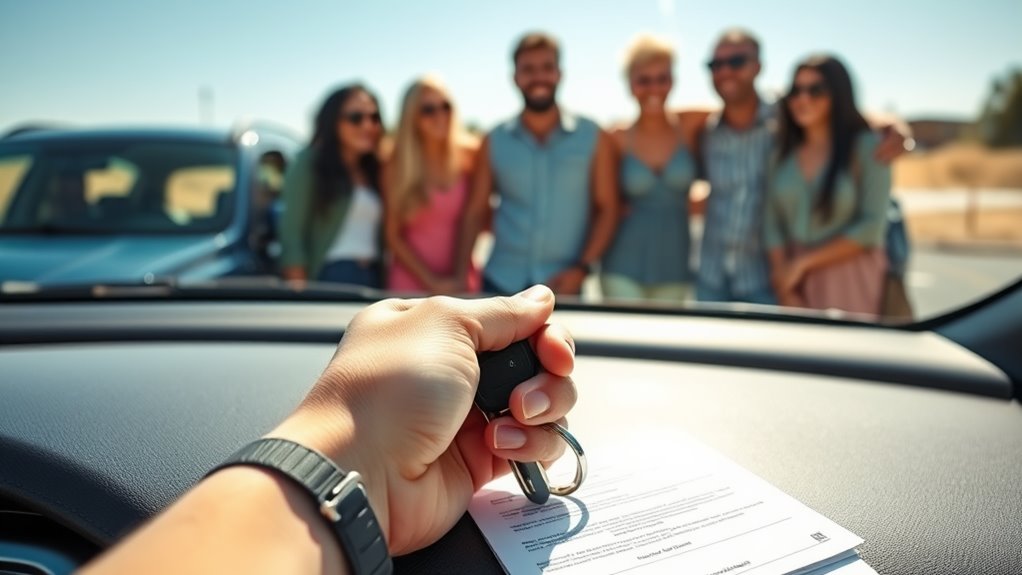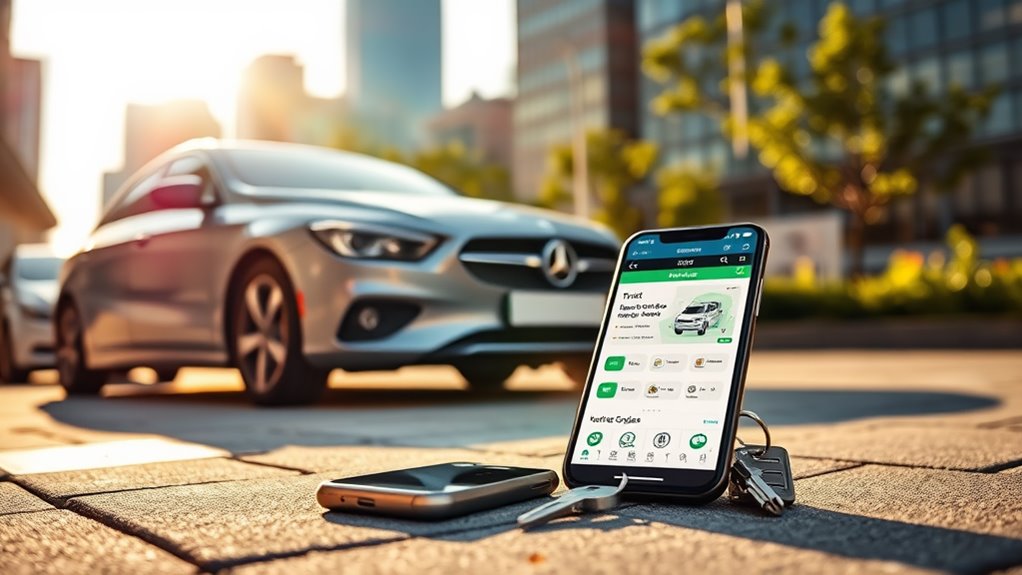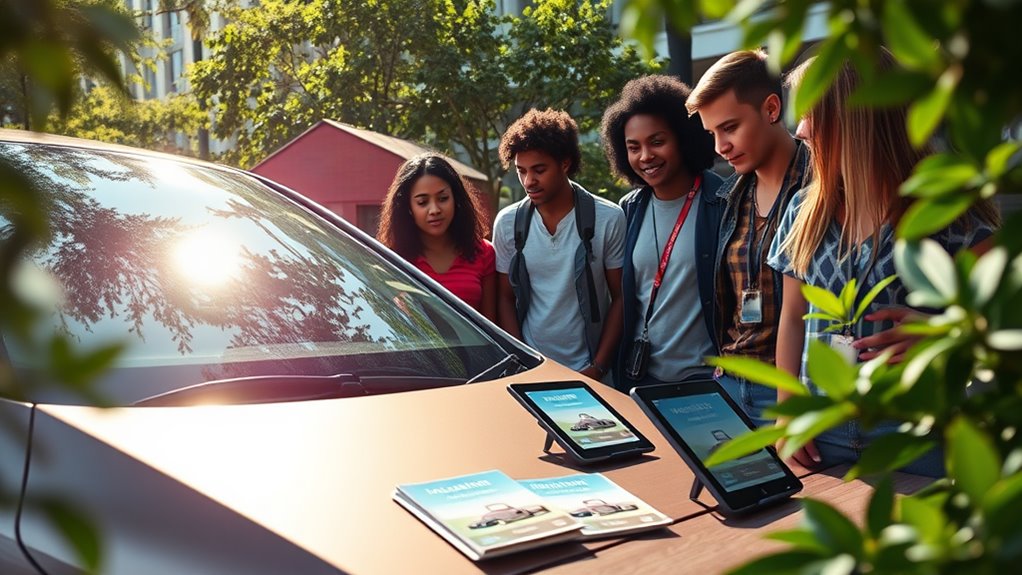You might think insuring a friend's car is straightforward, but it can get complicated quickly. Understanding the nuances of car insurance is crucial for avoiding potential pitfalls. Whether you're borrowing a vehicle or lending one, knowing the right steps can save you from future headaches. Let's explore practical tips that guarantee both you and your friends stay protected on the road.
Key Takeaways
- Verify the vehicle owner's insurance policy includes a permissive driver clause before driving their car to ensure coverage is valid.
- Communicate openly about each driver's history and any restrictions on their licenses to assess risk and responsibilities.
- Document all essential vehicle information, including insurance details and emergency contacts, to prepare for any incidents that may occur.
- Regularly review the insurance policy for coverage limits and exclusions to understand any potential gaps in protection while sharing vehicles.
- Discuss and establish clear responsibilities among all parties involved to address maintenance, damages, and accident procedures effectively.
Understand the Basics of Non-Owner Insurance

When you're frequently borrowing friends' or family members' cars, understanding non-owner insurance is crucial. This type of insurance provides liability coverage for drivers who don't own a vehicle but regularly drive others' cars. It covers bodily injury and property damage resulting from accidents, functioning as secondary coverage behind the vehicle owner's insurance. You might find non-owner insurance beneficial if you often borrow vehicles, rent cars, or are temporarily without a car. Additionally, this insurance is particularly useful for uninsured drivers who may need extra protection while driving non-owned vehicles. Non-owner insurance can also help you establish a good driving record, which is beneficial when you decide to purchase your own vehicle. Some states even require it if you have serious traffic offenses. By maintaining continuous coverage, you can avoid higher rates when you eventually purchase your own vehicle. Knowing these basics helps guarantee you're protected while driving someone else's car.
Verify Coverage Requirements for Borrowed Vehicles
How can you guarantee you're covered when borrowing a friend's car? Start by checking the vehicle's insurance card to verify it has current coverage details.
Research your state's insurance requirements and confirm if the policy includes a permissive driver clause, which covers you as an authorized driver. If you'll use the car for commercial purposes, be aware that you'll need additional coverage.
Always get permission from the owner, ideally documented. For clarity, contact their insurance provider to discuss liability coverage and any exclusions that could affect you in an accident.
Finally, familiarize yourself with local laws and make sure compliance with all driving regulations before hitting the road.
Assess the Driving Record of Your Friends
What factors should you consider when evaluating your friends' driving records? First, check for at-fault accidents and severe infractions, as these can lead to higher insurance premiums.
A history of multiple claims may also indicate a higher risk, which insurers closely monitor. Additionally, be aware that friends with poor records might face limited coverage options, potentially leaving both of you exposed to financial risks.
Verify they've valid driver's licenses and aren't subject to any restrictions. Finally, keep in mind that frequent claims can risk policy cancellation, so it's wise to maintain open communication about driving habits and insurance needs.
Evaluating these elements helps you make informed decisions when lending your vehicle.
Obtain Permission Before Borrowing a Car
Before borrowing a friend's car, it's essential to obtain clear permission to guarantee that both legal and insurance requirements are met.
Whether it's verbal, written, or implied through actions like receiving the keys, make sure the arrangement is understood.
Remember, permission doesn't grant you regular access; you shouldn't drive the vehicle frequently.
Also, you can't let anyone else drive the car without the owner's consent.
Failing to secure proper permission could jeopardize insurance claims in case of an accident.
Always communicate openly with your friend about the terms of use, ensuring you're both on the same page.
This step is important for maintaining trust and avoiding potential legal issues down the road.
Know the State Regulations on Car Insurance
Maneuvering state regulations on car insurance can feel overwhelming, but understanding these laws is vital when borrowing a friend's vehicle. Each state has different requirements, often mandating liability coverage for bodily injury and property damage.
For instance, Illinois requires minimums of 25/50/20, so be aware of your state's rules. It's important to have proof of insurance, as driving without it can lead to steep fines and license suspension.
Additionally, familiarize yourself with whether your state follows a fault or no-fault system, as this impacts financial responsibility in accidents. Always check for any exemptions that may apply and verify you're compliant to avoid penalties, which can severely affect your finances and driving privileges.
Keep Documentation Handy for Emergencies
When you're behind the wheel of a friend's car, having the right documentation can make all the difference in an emergency.
Start by keeping essential information handy, like the vehicle's details, including the make, model, and color, as well as the owner's insurance policy number. Document the location, date, and time of any incidents, along with weather conditions.
Keep essential vehicle information, including make, model, color, and insurance details, readily available for emergencies.
If an accident occurs, gather names and contact details of witnesses and take photos of the damage. Don't forget to obtain a police report if necessary.
Keeping these documents organized and readily accessible guarantees that you can efficiently handle any claims and provide the necessary information to the insurance company when it's needed most.
Consider Adding Frequent Drivers to Your Policy
Handling documentation is just the first step to guaranteeing safety and security while driving a friend's car. To enhance your coverage, consider adding frequent drivers to your policy. This includes family members, roommates, and employees who regularly use the vehicle.
By including them, you provide full coverage—even if they've their own insurance—minimizing financial risks in case of an accident. The process is straightforward: gather the driver's name, birthdate, license number, and driving history, then file the changes online or through your agent.
Keep in mind that adding inexperienced drivers may increase your premiums, so it's wise to assess the financial impact before making adjustments. Regularly reviewing your policy guarantees everyone who drives is adequately covered.
Review Policy Limits and Coverage Exclusions
Reviewing your policy limits and coverage exclusions is essential to guaranteeing you're adequately protected while driving a friend's car.
Start by checking your bodily injury liability limits, which dictate how much your insurance pays for medical expenses per person and per accident. Remember, each state has minimum requirements; for instance, California mandates $30,000/$60,000.
Next, evaluate your property damage coverage, which covers repairs for vehicles and property but won't cover your own without additional options.
Pay attention to exclusions, such as intentional damage or business use; these can greatly impact your protection. Understanding these limits and exclusions helps you avoid unexpected expenses and guarantees you're prepared for any situation while driving someone else's vehicle.
Explore Optional Coverages for Additional Protection
Understanding your policy limits and exclusions sets the stage for considering optional coverages that enhance your protection while driving a friend's car.
You might want to explore collision and extensive coverage, which protect against various damages. Gap insurance is essential if the car's totaled, covering the difference between its cash value and any outstanding loan.
Rental car reimbursement can ease the burden while the car's in the shop. Additionally, uninsured/underinsured motorist coverage safeguards you against drivers with inadequate insurance.
For further peace of mind, consider personal injury protection (PIP) and roadside assistance. Each of these optional coverages provides valuable protection, ensuring you're prepared for a range of unexpected situations while enjoying the drive.
Communicate Clearly About Insurance Implications
Before you share a vehicle with friends, it's crucial to communicate clearly about the insurance implications to avoid any misunderstandings.
Start by clarifying the coverage on your friend's policy, especially regarding rental use. Review any rental agreements to guarantee compliance with insurance requirements.
Highlight the potential risks of sharing vehicles, such as increased accident exposure. Discuss liability concerns, detailing who's responsible for damages or injuries.
Make certain to identify any exclusions in the policy that could create coverage gaps. If you're considering car-sharing, specialized insurance may be necessary.
Always emphasize transparency about responsibilities, including driver screening and vehicle maintenance, to make sure everyone understands their role in protecting both the vehicle and their insurance coverage.
Conclusion
In summary, safeguarding friends' cars safely requires diligence and clear communication. For example, if your friend has a history of accidents, it's vital to make certain their driving record aligns with your insurance policy's requirements. By discussing coverage options and responsibilities up front, you can avoid misunderstandings and protect both your friend and yourself. Regularly reviewing policies together will keep you both informed and prepared for any situations that may arise.







